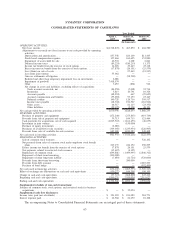Symantec 2009 Annual Report Download - page 125
Download and view the complete annual report
Please find page 125 of the 2009 Symantec annual report below. You can navigate through the pages in the report by either clicking on the pages listed below, or by using the keyword search tool below to find specific information within the annual report.Revenue Recognition
We market and distribute our software products both as stand-alone software products and as integrated product
suites. We recognize revenue when 1) persuasive evidence of an arrangement exists, 2) delivery has occurred or
services have been rendered, 3) fees are fixed or determinable and 4) collectibility is probable. If we determine that any
one of the four criteria is not met, we will defer recognition of revenue until all the criteria are met.
We derive revenue primarily from sales of content, subscriptions, maintenance and licenses. We present
revenue net of sales taxes and any similar assessments.
Content, subscriptions, and maintenance revenue includes arrangements for software maintenance and
technical support for our products, content and subscription services primarily related to our security products,
revenue from arrangements where vendor-specific objective evidence (“VSOE”) of the fair value of undelivered
elements does not exist, arrangements for managed security services, and Software-as-a-Service (“SaaS”) offer-
ings. These arrangements are generally offered to our customers over a specified period of time, and we recognize
the related revenue ratably over the maintenance, subscription, or service period.
Content, subscriptions, and maintenance revenue also includes professional services revenue, which consists
primarily of the fees we earn related to consulting and educational services. We generally recognize revenue from
professional services as the services are performed or upon written acceptance from customers, if applicable,
assuming all other conditions for revenue recognition noted above have been met.
License revenue is derived primarily from the licensing of our various products and technology. We generally
recognize license revenue upon delivery of the product, assuming all other conditions for revenue recognition noted
above have been met.
We enter into perpetual software license agreements through direct sales to customers and indirect sales with
distributors and resellers. The license agreements generally include product maintenance agreements, for which the
related revenue is included with Content, subscriptions, and maintenance and is deferred and recognized ratably
over the period of the agreements.
In arrangements that include multiple elements, including perpetual software licenses and maintenance and/or
services and packaged products with content updates, we allocate and defer revenue for the undelivered items based
on VSOE of fair value of the undelivered elements, and recognize the difference between the total arrangement fee
and the amount deferred for the undelivered items as license revenue. VSOE of each element is based on the price
for which the undelivered element is sold separately. We determine fair value of the undelivered elements based on
historical evidence of our stand-alone sales of these elements to third parties or from the stated renewal rate for the
undelivered elements. When VSOE does not exist for undelivered items such as maintenance, the entire
arrangement fee is recognized ratably over the performance period. Our deferred revenue consists primarily of
the unamortized balance of enterprise product maintenance, consumer product content update subscriptions, and
arrangements where VSOE does not exist.
Indirect channel sales
For our Consumer segment, we sell packaged software products through a multi-tiered distribution channel.
We also sell electronic download and packaged products via the Internet. We separately sell annual content update
subscriptions directly to end-users primarily via the Internet. For our consumer products that include content
updates, we recognize revenue for these products ratably over the term of the subscription upon sell-through to end-
users, as the subscription period commences upon sale to an end-user. For most other consumer products, we
recognize package product revenue on distributor and reseller channel inventory that is not in excess of specified
inventory levels in these channels. We offer the right of return of our products under various policies and programs
with our distributors, resellers, and end-user customers. We estimate and record reserves for product returns as an
65
SYMANTEC CORPORATION
Notes to Consolidated Financial Statements — (Continued)
























